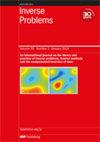Solving inverse obstacle scattering problem with latent surface representations
IF 2
2区 数学
Q1 MATHEMATICS, APPLIED
引用次数: 0
Abstract
We propose a novel iterative numerical method to solve the three-dimensional inverse obstacle scattering problem of recovering the shape of an obstacle from far-field measurements. To address the inherent ill-posed nature of the inverse problem, we advocate the use of a trained latent representation of surfaces as the generative prior. This prior enjoys excellent expressivity within the given class of shapes, and meanwhile, the latent dimensionality is low, which greatly facilitates the computation. Thus, the admissible manifold of surfaces is realistic and the resulting optimization problem is less ill-posed. We employ the shape derivative to evolve the latent surface representation, by minimizing the loss, and we provide a local convergence analysis of a gradient descent type algorithm to a stationary point of the loss. We present several numerical examples, including also backscattered and phaseless data, to showcase the effectiveness of the proposed algorithm.用潜在表面表示法解决反障碍物散射问题
我们提出了一种新颖的迭代数值方法来解决三维反向障碍物散射问题,即从远场测量中恢复障碍物的形状。为了解决反问题固有的求解困难性质,我们主张使用经过训练的表面潜在表示作为生成先验。这种先验在给定的形状类别中具有出色的表达能力,同时,潜在维度较低,大大方便了计算。因此,曲面的可容许流形是现实的,由此产生的优化问题也不那么困难。我们利用形状导数,通过最小化损失来演化潜曲面表示,并提供了梯度下降型算法到损失静止点的局部收敛分析。我们列举了几个数值示例,包括反向散射数据和无相位数据,以展示所提算法的有效性。
本文章由计算机程序翻译,如有差异,请以英文原文为准。
求助全文
约1分钟内获得全文
求助全文
来源期刊

Inverse Problems
数学-物理:数学物理
CiteScore
4.40
自引率
14.30%
发文量
115
审稿时长
2.3 months
期刊介绍:
An interdisciplinary journal combining mathematical and experimental papers on inverse problems with theoretical, numerical and practical approaches to their solution.
As well as applied mathematicians, physical scientists and engineers, the readership includes those working in geophysics, radar, optics, biology, acoustics, communication theory, signal processing and imaging, among others.
The emphasis is on publishing original contributions to methods of solving mathematical, physical and applied problems. To be publishable in this journal, papers must meet the highest standards of scientific quality, contain significant and original new science and should present substantial advancement in the field. Due to the broad scope of the journal, we require that authors provide sufficient introductory material to appeal to the wide readership and that articles which are not explicitly applied include a discussion of possible applications.
 求助内容:
求助内容: 应助结果提醒方式:
应助结果提醒方式:


